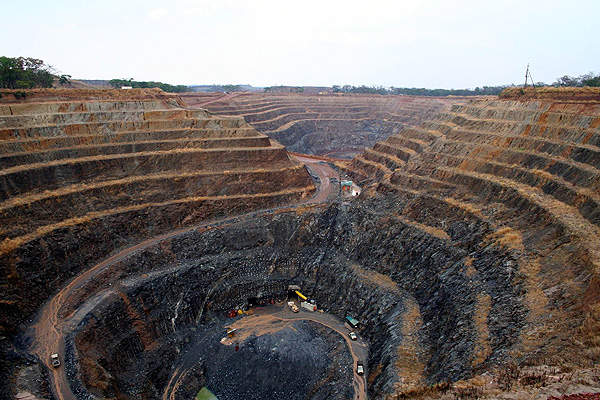This file is an NI 43-101 Technical Report on the Tulawaka Gold Property in Tanzania. The report was prepared byFrederick Gordon, a professional geologist with over 20 years of experience in gold exploration in Tanzania.Keynotes:
The Tulawaka Project is in the advanced exploration stage and includes a prospecting permit (PL) covering an area of approximately 5 square kilometres. The property is located in the Lake Victoria gold region, within one of Tanzania’s major ancient greenstone belts, and is 400 metres north of Barrick/MDN’s Tulawaka gold mine. The Tulawaka resource model incorporates recent data for optimal ore mining. The updated Tulawaka resource model at a COG of 1.5 g/tonne represents total mineral potential in the 0.22Moz indicated and inferred resource.
The property is located in the Lake Victoria gold region, within one of Tanzania’s major ancient greenstone belts, and is 400 metres north of Barrick/MDN’s Tulawaka gold mine. The Tulawaka resource model incorporates recent data for optimal ore mining. The updated Tulawaka resource model at a COG of 1.5 g/tonne represents total mineral potential in the 0.22Moz indicated and inferred resource.
"Empowering global investments and enhancing international relationships through expert consulting and strategic guidance." |  |
The Tulawaka Project is located in the same structural setting as the known gold mineralization at Tulawaka and is also closely associated with the Golden Pride shear zone, which hosts the major gold mines of Golden Pride (Resolute) and Buzwagi (Barrick).
* Tulawaka had two surface zones of quartz rubble, initially estimated to contain 246,000 tonnes grading 7.29 g/t gold or 57,700 gold ounces. The Tulawaka Project, particularly around the mining areas, has extensive quartz rubble at or near surface.
The ancient Tanzania Craton and its surrounding Proterozoic mobile belts cover much of the central Tanzania Plateau. Continentally derived sediments of Mesoproterozoic and younger ages cover parts of the craton, particularly in the east. Tertiary volcanics of mafic to intermediate composition, including carbonatites, are found primarily in the Kilimanjaro and East Rift regions in the north of the country.
The producing gold mines and other deposits of the Lake Victoria gold region are located in a series of ancient greenstone belts that are similar in age, lithology, and mineralization to the Abitibi belt of northern Ontario and Quebec. These linear greenstone belts are separated by east-trending granite-gneiss zones. Recent work, including exploratory drilling, has shown that some of the greenstone belts are more extensive than previously thought.
Tanzania is the third largest gold producer in Africa, after South Africa and Ghana. This has been achieved with the opening of five open pit mines (Golden Pride, Geita, North Mara, Tulawaka, and Buzwagi) and one large underground mine (Bulyanhulu) in recent years. Gold mining from bedrock deposits around Lake Victoria has been recorded since as early as 1898 and continued intermittently on a limited scale until the 1970s in the Mara, Musoma, Serengeti, Iramba Plateau and Gita regions.
Some mineralized areas are parallel to lithological bedding in the greenstones and others cross the bedding, particularly in the more potent units. Dilation vents along shear zones are common hosts for mineralization, often filling open spaces with replacement of adjacent wall rock in some places. Many are localized in the Banded Iron Formation (BIF), while only a few small deposits occur in granitoids, usually near the greenstone.
Previous work at Tulawaka by Barrick Exploration Africa Ltd. (BEAL) included soil sampling in 2002 by BEAL that highlighted several gold anomalies in the western half of the property in areas of known workings and associated with the Buntubili high-pressure zone. A subsequent study of the regolith concluded that much of the upper horizons had been moved, indicating that conventional shallow soil sampling may not be representative of the underlying bedrock and that the relative absence of high gold values in shallow soils does not necessarily reflect the potential for gold mineralization. Lower-level gold values may be significant and, as was later demonstrated by Tanzanian Royalty, may indicate important but subtle trends.
 Therefore, BEAL used vertical RAB drilling in a bedrock interface program in 2002-2003 with over 1000 m drilled across the property in multiple holes and identified four new gold anomalies in the soil as well as confirming some of the previously shallow soil anomalies. Overall, BEAL’s interpretation appears to focus only on the highest values and ignores other areas of finer values and regolith complexity.Analysis:
Therefore, BEAL used vertical RAB drilling in a bedrock interface program in 2002-2003 with over 1000 m drilled across the property in multiple holes and identified four new gold anomalies in the soil as well as confirming some of the previously shallow soil anomalies. Overall, BEAL’s interpretation appears to focus only on the highest values and ignores other areas of finer values and regolith complexity.Analysis:
The report provides comprehensive information on the Tulawaka Project, including its location, geology, exploration history and mineral resource estimates.
Pros:
The report complies with NI 43-101 standards and has been prepared by a qualified geologist.
The report includes recent exploration data that indicates significant potential for gold mineralization at Tulawaka.
Cons:
The report highlights some of the risks associated with the project, such as the potential for underground voids.
The report does not include detailed information on the capital and operating costs required to develop Tulawaka.
Conclusion:
The Tulawaka Project has significant potential for gold mineralization. However, a more detailed assessment of the risks and opportunities of this project is needed before any investment decisions are made.
| For more information about this project and personalized investment consulting in Tanzania, please contact us. Our team of experts is here to provide detailed insights and guidance to help you make informed investment decisions. | +989928374806 :whatsapp info@hamongostarsepanta.ir |
Specialized information and local contact number |
